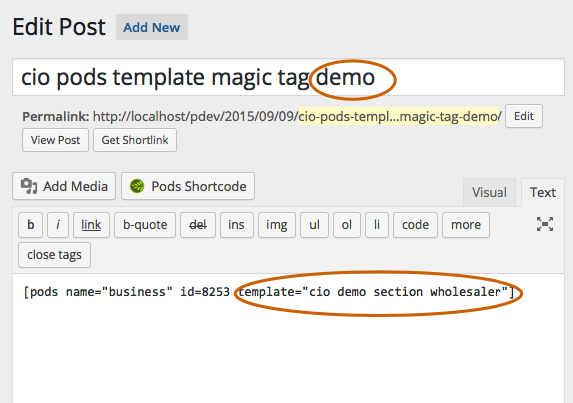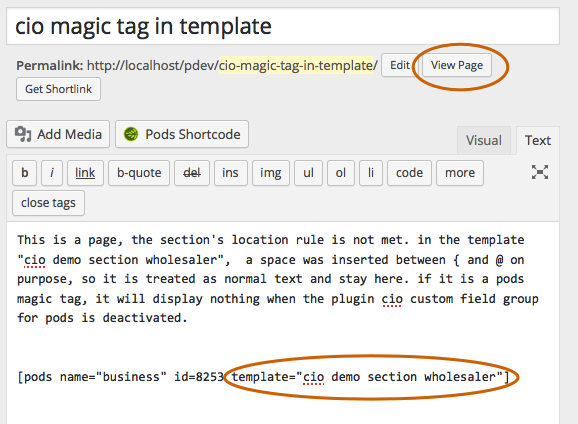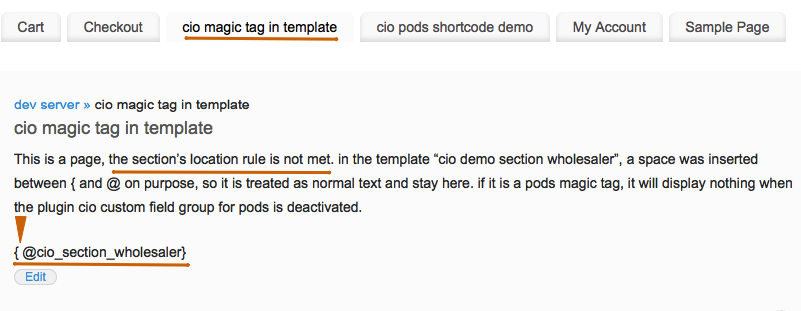
CIO Custom Field Groups for PODS
| 开发者 | VisualData |
|---|---|
| 更新时间 | 2017年12月26日 08:19 |
| 捐献地址: | 去捐款 |
| PHP版本: | 3.9.0 及以上 |
| WordPress版本: | 4.9 |
| 版权: | GPLv2 |
| 版权网址: | 版权信息 |
详情介绍:
Are you already using the awesome PODS plugin to manage your custom content types and fields?
Are you switching from Advanced Custom Fields to PODS but missing the groups and location rules found in Advanced Custom Fields?
Are you looking for a simple and easy way to present your custom field data on your website in logical blocks?
CIO Custom Field Groups for PODS may be the solution you are looking for. It makes PODS even more awesome.
PODS is a powerful and flexible framework to manage custom content types and custom fields. Some of PODS's unique features include
- extending WordPress's builtin content types (user, page, post, media, taxonomy)
- table storage, which is essential for high performance as the number of custom fields increase.
- Dividing custom fields into groups (under headers) and sub-groups (above footers).
- Configuring the header and footer field prefix, if you need to name the fields in a certain way for the database to integrate with other plugins/programs.
- Configuring the header and footer field background in the admin panel, so you will work with your favourite colours.
- Configuring the header and footer field css for frontend display.
- Setting up restriction access and display conditions similar to location rules of Advanced Custom Fields (ACF). So a group of fields can be displayed on a specified page or post, or pages or posts meeting certain criteria,
- Supporting pods-form short code and field based magic tags enclosed in short code or included in pods template, such as {@my_header}.
- Displaying sections of custom fields according to user roles or capabilities. For example, you may collect and display different information if the users are wholesalers.
- Display sections of custom fields on specified pages only.
- Admin only custom fields.
[pods-form name="mypod" id="321" headers="0, myheader1, myheader2" footers="myfooter1, myfooter2, 0" ]
Grouping is optional with CIO Custom Fields and Groups. If some fields are grouped and some are not, you can access these ungrouped fields by using a dummy header or footer name "0" (zero), as shown in the example above.
Note headers and footers are used in the short code instead of groups. This is to avoid confusion with the "group" functionality under development and testing by pods team.
CIO Custom Fields and Groups professional edition filters the parameters in the short code, identifies the fields in the group, and passes the field names to PODS to generate a form.
Similarly, CIO Custom Fields and Groups professional edition hooks into Pods to display a header and footer label only without an input cell.
CIO Custom Fields and Groups uses builtin table structures of WordPress and PODS to define groups. No extra taxonomy or data is created. The professional edition of CIO Custom Fields and Groups supports PODS shortcode and magic tags in shortcode template, and in the template component.
To display a group defined by the header field "my_header" from a custom post type called "product" with id 123, you would use the following short code.
[pods name="product" id=123] {@my_header} [/pods]
Alternatively if you enable the component template, you can create a template containing the following line for example
<div class="my-custom-group-class"> {@my_header} </div>
Let's assume the template is called "my header template", and then you may use the following short code to display the group.
[pods name="product" id=123 template="my header template"]
Output from pods functions
$pod->field($my_header): null
$pod->fields(): all the fields including header fields
$pod->display($my_header): null
If you are using PODS and in some web pages looping through all fields to display content or form, after you have activated this plugin and created header fields, your existing code should still work without modification. The header fields will simply display a label for human comprehension.
When CIO Custom Fields and Groups professional edition is activated, and preset display conditions are met, the custom fields belong to this group will be displayed.
When CIO Custom Fields and Groups professional edition is deactivated, the above shortcode simply displays nothing, as no data is ever stored in the special relationship field "my_header".
Please see screen shots for more examples.
CIO Custom Fields and Groups Professional Edition comes with
- unlimited site license. you can use it on as many websites as you like, either owned by you or your clients, or your neighbors, or your friends.
- life time free support, if you have paid an one-off fee to upgrade to professional edition
- life time free upgrade, if you have paid an one-off fee to upgrade to professional edition
- 30 day money back guarantee. no questions to ask.
安装:
To install the CIO Custom Fields and Groups, unzip the downloaded zip file and upload the folder to /wp-content/plugins/, and then activate the plugin from the Plugins page in WordPress.
If you are using the free plugin and bought the professional edition, please remove the free plugin before installing the professional edition.
屏幕截图:
更新日志:
1.0.0
- Initial release.













